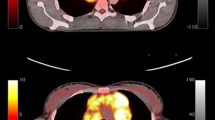Abstract
Fluorine-18 fluorodeoxyglucose positron emission tomography (PET) has a number of potential advantages for the oncologist in refining and improving the management of lymphomas. Currently the most promising appear to be in the early prediction of response to chemotherapy, evaluation of the residual mass and improved radiotherapy planning. Other important areas which require assessment are its value in refining prognostic indices at staging and its role in follow-up. The added value of the new combined PET-CT scanners requires careful evaluation in each of these settings, where combined morphological and functional information may provide optimal disease assessment. The ultimate aim is to improve the management of patients with lymphoma by identifying those patients who can be cured with minimal treatment and equally those for whom conventional treatment is doomed to failure and in whom more intensive strategies should be employed from the outset.
Access this article
We’re sorry, something doesn't seem to be working properly.
Please try refreshing the page. If that doesn't work, please contact support so we can address the problem.

Similar content being viewed by others
References
Hasenclever D, Diehl V. A prognostic score for advanced Hodgkin's disease. N Engl J Med 1998; 339:1506–1514.
The International non-Hodgkin's Lymphoma Prognostic Factors Project: a predictive model for aggressive non Hodgkin's lymphoma. N Engl J Med 1993; 329:987.
Hoskin PJ. FDG PET in the management of lymphoma: a clinical perspective. Eur J Nucl Med 2002; 29:449–451.
Buchmann I, Reinhardt M, Elsner K, et al. 2-(Fluorine-18)fluoro-2-deoxy-d-glucose positron emission tomography in the detection and staging of malignant lymphoma. A bicenter study. Cancer 2001; 91; 889–899.
Bangerter M, Moog F, Buchmann I, et al. Whole-body 2-[18F]-fluoro-2-deoxy-d-glucose positron emission tomography (FDG-PET) for accurate staging of Hodgkin's disease. Ann Oncol 1998; 9:1117–1122.
Partridge S, Timothy A, O'Doherty MJ, et al. 2-Fluorine-18-fluoro-2-deoxy-d glucose positron emission tomography in the pretreatment staging of Hodgkin's disease: influence on patient management in a single institution. Ann Oncol 2000; 11:1273–1279.
Mikhael NG, Timothy AR, O'Doherty MJ, Hain S, Maisey MN. 18-FDG-PET as a prognostic indicator in the treatment of aggressive non Hodgkin's lymphoma—comparison with CT. Leuk Leukaemia 2000; 39:543–553.
Maisey NR, Hill ME, Webb A, et al. Are18fluorodeoxyglucose positron emission tomography and magnetic resonance imaging useful in the prediction of relapse in lymphoma residual masses? Eur J Cancer 2000; 36:200–206.
Lucraft HH. Strategies to reduce deaths from breast cancer following mantle irradiation. Clin Oncol 2000; 12:276–277.
Hoskin PJ. The price of anticancer intervention: secondary malignancies after radiotherapy. Lancet Oncol 2002; 3:577–578.
Chronowski GM, Wilder RB, Tucker S, et al. Analysis of in field control and late toxicity for adults with early stage Hodgkin's disease treated with chemotherapy followed by radiotherapy. Int J Radiat Oncol Biol Phys 2003; 55:36–43.
Spaepen K, Stroobants S, Dupont P, et al. Prognostic value of positron emission tomography (PET) with fluorine-18 fluorodeoxyglucose ([18F]FDG) after first-line chemotherapy in non-Hodgkin's lymphoma: Is [18F]FDG-PET a valid alternative to conventional diagnostic methods? J Clin Oncol 2001; 19:414–419.
Miller TP, Dahlberg S, Cassady JR, et al. Chemotherapy alone compared with chemotherapy plus radiotherapy for localized intermediate- and high-grade non-Hodgkin's lymphoma. N Engl J Med 1998; 339:21–26.
Moody AM, Pratt J, Vaughan Hudson G, Smith P, Lamont A, Williams MV. British National Lymphoma Investigation: pilot studies of neoadjuvant chemotherapy in clinical stage Ia and IIa Hodgkin's disease. Clin Oncol 2000; 13:262–268.
Wirth A, Wolf M, Prince HM. Current trends in the management of early stage Hodgkin's disease. Aust NZ J Med 1999; 29:535–544.
Author information
Authors and Affiliations
Corresponding author
Rights and permissions
About this article
Cite this article
Hoskin, P.J. PET in lymphoma: what are the oncologist's needs?. Eur J Nucl Med Mol Imaging 30 (Suppl 1), S37–S41 (2003). https://doi.org/10.1007/s00259-003-1158-5
Published:
Issue Date:
DOI: https://doi.org/10.1007/s00259-003-1158-5




